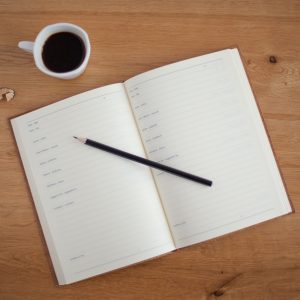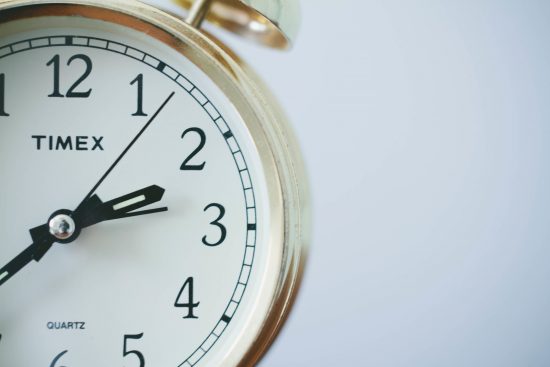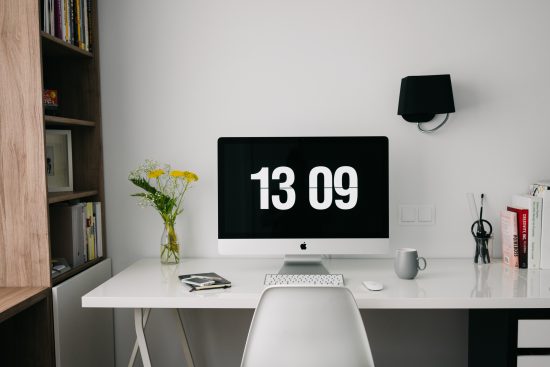
Image via Unsplash.
Confession time:
I’ve never pulled a work-related all-nighter.
I went my entire academic career never cramming for a test, or staying up until 3 am to finish a paper. I don’t personally know the feeling of seeing the sun gently creep above the horizon as I work, frantically, to finish a project.
Now, part of that can be put down to the fact that (at the risk of sounding cocky) I have cultivated decent time management skills. It’s also based on the fact that I have a very clearly defined sense of when, where, and how I am most functional.
When it comes to working at night (and especially if it involves extensive research, writing, or critical thought—all things that both my work and my university experience demanded of me in spades) I am essentially useless. Once 7 pm hits, I am no longer capable of producing good quality work. Evenings, for me, are for socializing, errands, Netflix, a glass of wine—you get the idea.
Though I could choose to power through, I prefer to take a different approach. Instead of forcing myself to do work in a context in which I know my output will be inferior, I make an effort to work with what I know suits my work preferences. This brings us to the idea of the “user manual.”

Image via Unsplash.
Creating your own “user manual”
The longer we spend working (whether that be at school, at our jobs, starting our businesses, or on pet projects), the more evident it becomes that we have certain times of day and environments that encourage us to do our best work.
You might have discovered that you prefer to do emails in the morning over coffee (or they just won’t get done), that the Pomodoro technique really helps you focus on projects, or that you do your best creative work while listening to a classical radio station with noise canceling headphones.
Rather than simply letting this information float around in your mind and disappear just as quickly, consider honing in on it.
Spend some time determining where you work best, what time of day you get the most done, and what atmosphere you require to be as productive, creative, and efficient as possible. What systems need to be put in place to help maximize your output? How can you optimize your environment, lifestyle, and surroundings to get the best possible out of yourself?
In essence, you’re creating what I’ll be referring to in this article as your own personal user manual.

Image via Unsplash.
What is a personal user manual?
Your personal user manual is a guide to using, well, you.
Whether formal and written up, or a clear mental reference point, your user manual is a guide that, if followed, will enable you to perform at your best.
Just like your car, household appliances, and entertainment systems come complete with operating instructions, your user manual is a set of guidelines illustrating how to operate you.
Your personal manual is really primarily for your benefit. By taking the time to critically think about your own working preferences, you can better optimize your schedule and choices to do your best work.
Questions to ask yourself when creating your own user manual

Image via StockSnap.
1. Are you an early bird or a night owl?
We’ll start with the obvious question: When do you work best?
Generally speaking, when it comes to a preferred time of day to get things done, people tend to fall into distinct camps.
As I mentioned earlier, I am lousy at night. However, I’m not great in the early morning, either. I wouldn’t call myself a night owl or an early bird.
But, I have noticed that I do my best writing and my most focused work in general between 11 am and 4 pm.
So, what does that mean?
It means I exploit that window of time and make sure to schedule the tasks that require my most creative critical thinking during that time of day.
That doesn’t mean that the rest of the day is a waste; it just means that maybe, for example, I’ll bookend this section of the day with tasks like answering emails and lighter administrative work that requires less creativity and concentration.
To start, think about when you work best, and what kind of work you do best at different times. You may find that you have multiple times of day that suit your work style, or that you prefer to do different types of work at different times throughout the day.
Our internal biological clock is to an extent predetermined, meaning that if you have an inherent preference toward working at one particular time of day, it’s likely that you’ll continue to do your best work by taking advantage of this inclination.
Basically: Don’t fight it. Work with it.

Image via Unsplash.
2. Do you prefer to work in short spurts, or press on through?
Do you like breaking up your workday and switching gears often, or do you like to focus on one project until it’s completed?
I’m good for about an hour of focused, unbroken work, and then I need a break. I mentioned in a previous article that I’m a big fan of breaking up my workday—whether that be by taking a fifteen-minute walk, running down the street for a cup of coffee, or taking a lunchtime run.
However, some people prefer to push straight through a project. While the Pomodoro technique has a huge fanbase, other work/break strategies have been found to work as well, such as 52 minutes of work followed by a 17-minute break.
Determining how much time you like to work before taking a break can help you maximize your productivity and output. I know that I’ll need to stand up, move around, and have a mental break, so implementing the Pomodoro technique or scheduling in time for a walk makes me more productive.
This is because, rather than feeling overwhelmed by the fact that I have, say, five more hours in the day to work, I can mentally commit to an hour of work, a five-minute break, another hour of work, and so on.

Image via Unsplash.
3. What atmosphere makes you feel the most productive, creative, inspired?
Do you prefer to work in complete silence, or with music? What type of music? Do you like a formal office setup, or do you do your best work from the couch, or a coffee shop?
There are upsides to working in a formal workspace (such as an office or coworking space), working from your home, working at a coffee shop, or similar. You can find data to back up the benefits of all of the above—there’s no general consensus on what is really the best working environment.
Figuring this one out for yourself should be fairly intuitive; you probably already have a sense of what works best for you. However, it can be easy to fall into a habit of convenience and comfort.
As a remote worker, I can work from my couch, if I really want to. But, I know that I do not produce my best work from my couch. Why? I’m not really sure; perhaps it’s the lack of urgency and formality. However, I do my best writing at a coffee shop, so part of creating my own user manual means making an effort to schedule out days where I’ll work out of the house, no exceptions.
In addition, I enjoy a good pair of noise-canceling headphones, and have certain albums in rotation for different types of work. Studies suggest that music may make repetitive tasks easier and that ambient background noise can increase creativity, which might explain why I prefer certain music for answering emails, and different music for writing.
If you’re unsure of what works best for you, spend some time playing around. You’ll be able to tell pretty easily what works and what doesn’t based on your ability to focus and the quality of your work.

Image via Unsplash.
4. Do you prefer clear structure or a freeform rule set?
I am the type of person who enjoys lists, structure, and clearly-defined parameters. I feel uncomfortable starting a project where the requirements have not been clearly laid out for me, and where I haven’t yet created a list of tasks or action items that need accomplishing. It’s been suggested that limitation can actually increase creativity, and I personally know that defined parameters suit me best.
Maybe you’re the same way—or perhaps you’re the complete opposite. Does the idea of creating an outline or a checklist before you start a project hem you in, and make you feel constricted, as though it’s preventing you from really starting? You might genuinely perform better with a more flexible, free-form structural approach.
There’s an ongoing debate between the benefits of a more flexible schedule versus more rigidity, but chances are, you’re self-aware enough to know what works best for you. I know that I function best with structure, hard deadlines, and clearly-defined parameters. For some, this level of rigidity kills creativity.
So, it’s important to make an effort to structure your work to best reflect your preferred style. I know that without a clearly defined plan, I get overwhelmed; so, I take the time to plan. Maybe you’ll find that you really can’t stand lists and that they’re ultimately a waste of time for you personally, and you’d rather dive right in.

Image via StockSnap.
5. Does ambiance matter to you? What helps, and what hurts?
In the same vein as point #3, I am pretty picky about the type of atmosphere in which I work.
For instance, I can’t stand working in a messy or disorganized environment. According to a study by the Princeton University Neuroscience Institute, a cluttered environment can restrict our ability to focus, which can potentially lead to lower productivity.
Maybe you’re the same way—or maybe you enjoy a little cozy clutter. It has also been suggested that highly creative people work a little differently than the rest of us; it’s possible that you prefer an element of organized chaos.
Whichever side of the coin you find yourself on, setting up your workspace to best reflect your working preferences is a big part of creating your own user manual.

Image via Unsplash.
6. Do you require solitude or collaboration?
In school, I was never the type of person who enjoyed a group study session; I preferred to study alone. However, a well-designed collaborative environment can actually increase productivity, and even working simply in the presence of others (versus alone in your home) can have a similar effect. The trend toward open workplaces, which has become increasingly favored in recent years, reflects the potential benefits of group work and collaboration.
When it comes to working alone versus in a group, different people will also have different preferences based on personality. Introverts, for example, may feel more comfortable working alone and prefer to work less collaboratively than their extroverted counterparts.
Which works best for you? Maybe it’s a combination of a few hours a day of solitary, uninterrupted work from your home, coupled with some time spent at a coffee shop, and an occasional collaborative session with your mentors, clients, or others in your industry.
Developing your user manual is an ongoing process
Ultimately, developing your own personal user manual is an iterative, ongoing—potentially lifelong—process.
It’s about getting a sense of what your work habits and needs are, works best for you, and how to optimize your workplace and schedule to best meet your needs.
What are some important aspects of your own personal user manual? I’d love to hear what works for you and what doesn’t. Let me know in the comments!

